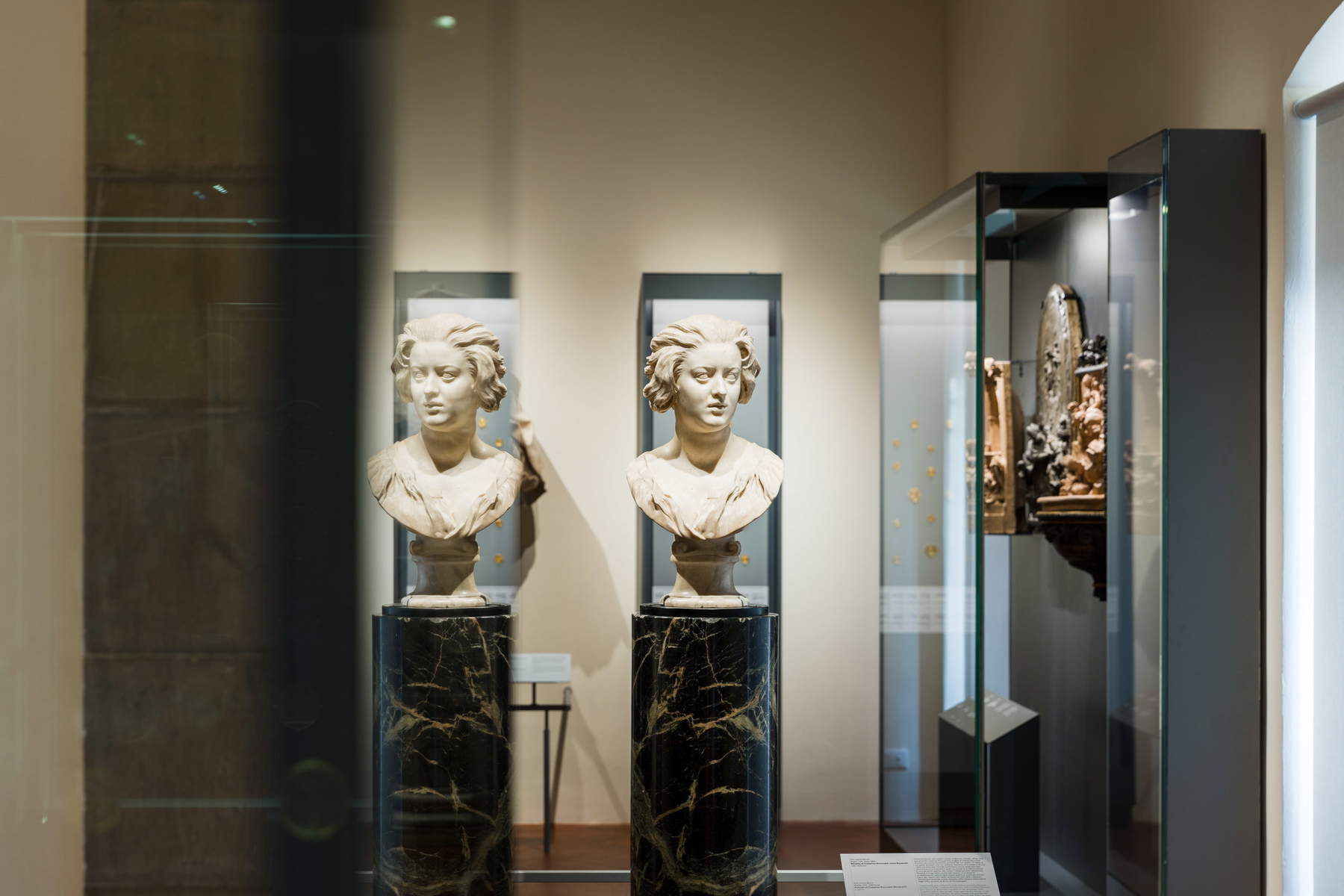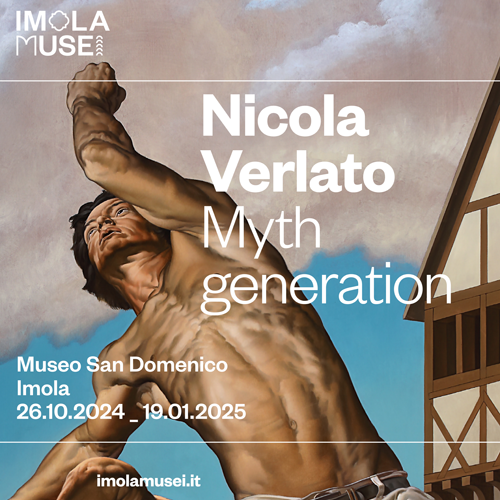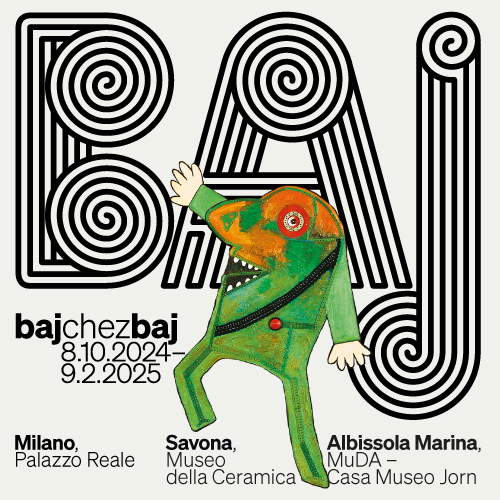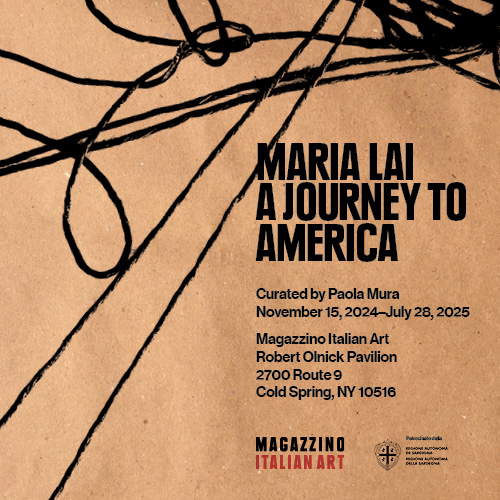Florence, new Medagliere and Baroque Sculpture Room opened at Bargello
A selection of some 240 medals, 22 coinages, and a rare punch from the ancient Medici-Lorraine medagliere, and a nucleus of very important Baroque sculptures, counting, among others, Gian Lorenzo Bernini’s portrait of Costanza Bonarelli, Massimiliano Soldani Benzi’s bronze reliefs, and Giuseppe Piamontini’s bronzes, some of the wax models recently donated to the museum by Marquis Lionardo Lorenzo Ginori Lisci. These are just some of the protagonists of the new Medagliere and Baroque sculpture rooms on the second floor of the Bargello National Museum. The rearrangement, which follows those already carried out in the Sala degli Avori, Cappella della Maddalena, Sagrestia and Sala della Scultura Medievale, and those, concomitant, underway in the Sala Islamica and Sala delle Maioliche, scheduled for completion in spring 2024, are part of the tight schedule of major works that began in 2016 in all the Bargello Museums.
The project aims at the valorization, according to updated museographic and historiographical criteria, of the Bargello’s extraordinary collection of medals (which counts more than 10,000 pieces) and of the seventeenth- and eighteenth-century sculptures in different materials, works by the greatest exponents of the Roman and Tuscan Baroque, from Gian Lorenzo Bernini and Francesco Mochi and Alessandro Algardi, from Giovanni Battista Foggini to Giuseppe Piamontini and Massimiliano Soldani Benzi. Medals, marble portraits, as well as bronzes and sketches, in wax and terracotta, all works better known to scholars than to the general public, of primary cultural and artistic importance within the Italian heritage.
Medagliere and baroque hall: reorganization project
The two rooms were included in the museum itinerary as early as 1932, when the bronze collection was set up. Shortly afterwards the medals were placed there, but the rooms were closed to the public for many decades. The medagliere and the nucleus of Baroque sculptures have been the subject of several displays in the Bargello’s nearly 160 years of intense museum life. The medals occupied two entire rooms on the second floor in the last quarter of the nineteenth century with thirty-five wooden showcases, only to be drastically but wisely reduced in the 1990 layout when the Medagliere reopened to the public after many years. In that set-up, under the direction of Giovanna Gaeta Bertelà, the medals (in smaller numbers, but still over a thousand units) found a new order in thirteen restored antique showcases, while only a few of the marble and bronze works from the seventeenth and eighteenth centuries were displayed in the two rooms. In 2018, Matteo Ceriana, an official art historian, together with Maria Cristina Valenti, an official architect and head of the technical office, had begun to draw up the preliminary plan for the rearrangement of the Medagliere and the nucleus of seventeenth- and eighteenth-century sculptures in the Baroque Hall, defined by architect Valenti, together with the Director, Paola D’Agostino. At the end of 2019, the halls were closed to begin the refitting operations, but following the 2020-2021 pandemic emergency, the project was halted due to lack of funds and the simultaneous start of other major works at the Bargello and the group’s other museums.
 Medagliere
Medagliere
 Medagliere
Medagliere
Funding and collaborations
In 2018, a grant of €150,000, received through loan fees, had been earmarked for the Baroque Hall works, which had been used in part for the new air conditioning systems in the two rooms, and a contribution was donated, through Art Bonus, by the Fondazione il Bargello Onlus for the new educational apparatus in Italian and English. But it was thanks to an extraordinary grant of €490,000 from the Ministry of Culture (programming of Law No. 190 of December 23, 2014 - Annual 2021-2023) that it was possible to resume the project for the two rooms. Matteo Ceriana retired, followed a year later by Maria Cristina Valenti, who had outlined the project in fundamental lines. In the summer of 2022, the executive project was finalized by the technical office of the Bargello Museums with the internal appointment of the official architect Costantino Ceccanti as Single Project Manager and the identification of surveyor Tommaso Tassini, an external professional, as safety coordinator. The tender for the construction of the new storefronts was won by Goppion Spa. Construction management was entrusted to architect Elena Magazzini, an outside professional, and last May work began on the new modern storefronts, and the restoration and adaptation of some of the 19th-century storefronts was completed. Alongside Costantino Ceccanti, surveyor Ilaria Castellani and restoration officer Benedetta Cantini were the operational directors of the project, with the assistance of Vincenzo De Magistris, technical assistant, and Carla Secciani, who oversees the storerooms and worked with meticulous care on the disassembly, conservation and rearrangement of all the medals, coordinated by the director, Paola D’Agostino. In addition to the Goppion firm, the firms Opera Laboratori Fiorentini and Rimani, to whom the lighting of the new rooms is due, the electrical firm Vannetti, ERISIST for special installations, the upholstery firm Pierozzi, and the firm ASC, which put in place a modern sliding door that allows the maintenance of constant temperature, worked on the project.
The graphic design and implementation of the apparatuses were carried out by Stampainstampa. In the Medagliere Hall, the Bargello’s technical team and architect Magazzini worked in close synergy with the Scuola Normale Superiore di Pisa. The selection of medals, cones, and punch, was supervised by Professor Lucia Simonato, author of contributions of primary importance to the history of the medal. Thirty-five percent of the works now on display were not present in the previous exhibition. The project benefited from the research and valuable collaboration of Giulia Daniele, winner of a 60 percent co-funded grant from the Bargello Museums, announced by the Scuola Normale with the title Le medaglie del Bargello: studi storico-artistici e strategie espositive. For the study, diagnostics and analysis of medals, the Bargello has in fact been able to count on a fruitful scientific exchange with the Scuola Normale thanks to the MeB 2020-2022 project (Knowing and preserving the Bargello’s small metals: new historical-artistic and scientific investigations on medals and plaques of the modern age), coordinated by Professor Simonato and co-funded by the Region of Tuscany, as part of the Giovanisì program, the Scuola Normale Superiore of Pisa and the company R.i.c.om and by a liberal donation, through Art Bonus, from Dr. Mario Scaglia to the Bargello National Museum, thus demonstrating attention to the indispensable role of the museum as a territorial network between various institutions.
The Medagliere and Sala Barocca: the route of the new layout
The Medagliere as we see it today houses some of the most relevant specimens, from the fifteenth to the nineteenth century, among the many kept in the Museum, which can boast a collection of more than ten thousand pieces, among the richest and most valuable collections in the world. In the center of the room, two showcases respectively celebrate Renaissance cast medals and Medici medals, the latter in direct relation to the series of porphyry medallions by Francesco del Tadda that decorate the top of one of the walls. The historical showcases are then respectively devoted to four different thematic nuclei, with papal medals, portraits of artists and men of letters, reverses with architecture, and a selection of cast medals from the Tuscan Baroque. For the first time ever, a number of cones and a punch, of which the Bargello also has a very important collection, are displayed alongside the medals, useful in providing visitors with insights into medallic production techniques. Behind Mochi’s wax and the respective medal, which already introduce to the next Baroque Room, the back wall finally hosts a selection of foreign gold medals, emblematic of the intense diplomatic relations maintained by the Medici family, while a special showcase displays two gilded bronze medallions by Jacopo Bonacolsi known as ’L’Antico,’ masterpieces of Renaissance cast plastic.
The Hall of Baroque Sculpture at the Medici Court opens with Bernini’s celebrated Costanza Bonarelli, which, having remained in Bernini’s studio for a long time, was probably donated by the same sculptor to Cardinal Giovan Carlo de’ Medici (1611-1663) in 1645, thus flowing into the Florentine collections and immediately being displayed in the Uffizi Statuary Gallery alongside Michelangelo’s Brutus. The portrait was transferred to the Bargello in 1873, becoming the subject of frequent moves around the rooms, given the difficulty of setting up an emblematic Baroque portrait in a context of predominantly Renaissance masterpieces. The portrait, which has become celebrated, illustrates the development of the relationship between Roman and Florentine Baroque sculptors, an indispensable but hitherto absent chapter in the museographic choices of the world’s leading museum of Italian sculpture. To give an account of the attention to the natural datum of the early seventeenth century, a showcase has been devoted to the so-called ’scorticato,’ the first wax anatomical model of the human body, which was made following repeated live study sessions carried out by Cigoli at the Florentine hospital of Santa Maria Nuova, to which various preparatory drawings bear witness. In the mid-seventeenth century, the work was acquired by Francesco Fontani, a courtier of the Grand Duchess of Tuscany Vittoria della Rovere (1622-1694), only to be sold to Cardinal Leopoldo de’ Medici (1617-1675). The waxwork is flanked by Giovanni Battista Foggini’s beautiful bronze statuette, documenting the fortune of the piece, from which numerous copies were made over the centuries.
Also on display again are a number of terracotta and wax sketches, which had been in storage for several decades, including the terracotta sketch for the funeral monument of Pope Innocent XI Odescalchi, purchased by the Italian state in the early twentieth century for the Bargello, with a new awareness in the field of protection and the desire to create a museum of sculpture with a broader scope. Roman Baroque sculpture had a fundamental influence on Tuscan artists, thanks in part to the establishment in 1673 by Cosimo III of a Florentine Academy in Rome, designed precisely to encourage the updating of painters and sculptors active in the Medici court. Cosimo III’s patronage determined the revival of Florentine bronze sculpture and encouraged, in the wake of Algardi, the local revival of relief sculpture. A singular bust, possibly depicting Cardinal Giovan Carlo de’ Medici, recently attributed to Giovanni Gonnelli, known as “the blind man from Gambassi,” represents a very rare survival of a clay portrait and is on public display for the first time. Giuseppe Piamontini’s St. Louis of France, among the most important Baroque bronzes preserved at the Bargello, and part of the famous series of twelve bronzes commissioned by the Electress Palatina for her apartments in the Pitti Palace, finds a new home in this room. The Baroque was also a ’golden age’ of the medal, as the specimens selected for this room and juxtaposed with coeval sculptures by Giovan Battista Foggini, Massimiliano Soldani Benzi and Giuseppe Piamontini demonstrate.
Also on public display for the first time on this occasion are four of the wax models recently donated to the Bargello by Marquis Leonardo Lorenzo Ginori Lisci, in dialogue with the museum’s permanent collection. The highly original Vase with the Triumph of Neptune, designed by Massimiliano Soldani Benzi in 1721, and derived from the forms sold in 1744 to Marquis Carlo Ginori by the sculptor’s son, Ferdinando, and the large wax relief by Giovan Battista Piamontini, with the Massacre of the Innocents, from a model by Giuseppe Piamontini. Also on display are Apollo and Daphne, borrowed from Bernini’s celebrated masterpiece, and The Death of St. Benedict, from a model by Massimiliano Soldani Benzi. The donation of the important corpus of waxes makes it possible to illustrate the interest of Marquis Carlo Ginori, founder of the prestigious Manifattura in 1737, the first in Italy, in shaping the so-called “white gold,” which from the very first years of activity acquired numerous forms from the workshops of leading Florentine sculptors so that they could then be used in the production of porcelain, thus giving impetus to highly original sculptural production and new strength to the prestige of Florentine Baroque sculpture, which became highly sought after in Italian and European courts. Sculptures, sketches and medals are thus interwoven in a polyphonic chorus, in which different materials and techniques exemplify the sumptuousness of Florentine Baroque production.



Statements
“I am very pleased that this project, on which we have been working for almost five years, has also come to a conclusion by 2023,” said Director Paola D’Agostino, “The project was all developed with the skills and knowledge of internal officials and employees of the Ministry of Culture, I thank for all the architect Maria Cristina Valenti, now retired, but who with me strongly wanted it. The project also benefited from various sources of funding in a virtuous synergy between the public and private sectors. Thanks to the prestigious scientific collaboration with the Scuola Normale Superiore of Pisa to curate the layout and research on medals, an artistic type generally hostile to the general public, we can better communicate to visitors the value of the medal, a real tool for promotion and social communication of the time. The new room dedicated to Florentine Baroque sculpture at the Medici court illustrates the developments of Tuscan sculpture after the death of Giambologna and the intense relationship that Tuscan sculptors, thanks in part to the central role of Cosimo III dei Medici, had with the Roman Baroque.”
“It could be argued, without fear of contradiction, that Baroque sculpture addresses first the emotions and then the intellect,” said Luke Syson, director of the Fitzwilliam Museum in Cambridge, “At the center of the new room devoted to Baroque art in the National Museum of the Bargello is Bernini’s most personal work, an object around which lustful, murderous, generative, destructive, creative emotions swirl. In this context, Costanza Bonarelli’s portrait appears stronger, more tender, more vulnerable, and more beautiful than ever. Paola D’Agostino is a great scholar of the sculpture of this period, and all her thought and expertise have flowed into this space. It is wonderful that inside one can appreciate this great masterpiece, probably still too little known, with works that few have seen: terracottas by Monnot and Algardi and waxes from the Ginori collection of Soldani and Piamontini. They too pulsate with feeling, but need careful examination to understand their compositional complexities and narrative tactics. Moreover, the Bargello has one of the most important collections of Renaissance and Baroque medals, and the new Medagliere, whose selection was curated by Lucia Simonato, is the result of a splendid design choice that respects the past and looks to the future. There is literally no other place in the world where you can admire such a marvel.”
“We are very pleased with the MeB project, the results of which were fundamental to the remounting of the Medagliere of the Bargello National Museum,” commented Lorenzo Bacci, Education, Training, Research and Labor Directorate of the Tuscany Region, “MeB, funded by the Tuscany Region with ESF, ”was was selected through a call for proposals that aimed to promote collaboration between operators in the cultural supply chain, universities and research centers, to carry out projects where collaboration between experts in the humanities and technical-scientific disciplines, would enable solutions to concrete problems expressed by cultural operators. The National Museum of the Bargello, the Scuola Normale Superiore of Pisa and the R.i.c.o enterprise, have interpreted the aims of the call in an exemplary way, the results obtained, which may be replicable in other contexts, and the concrete spin-offs of the project are an excellent testimony to this."
“The Bargello National Museum’s collection of medals stands out for being one of the most conspicuous and valuable collections globally,” explained Professor Lucia Simonato of the Scuola Normale Superiore in Pisa, “intimately connected with the vicissitudes of the Medici, with their political establishment and with the richness of their diplomatic networks in the modern age. This is a collection that has been the subject of constant scholarly attention and on which a fundamental chapter in the modern history of the art of the medal has been built.”
 |
| Florence, new Medagliere and Baroque Sculpture Room opened at Bargello |
Warning: the translation into English of the original Italian article was created using automatic tools. We undertake to review all articles, but we do not guarantee the total absence of inaccuracies in the translation due to the program. You can find the original by clicking on the ITA button. If you find any mistake,please contact us.





























